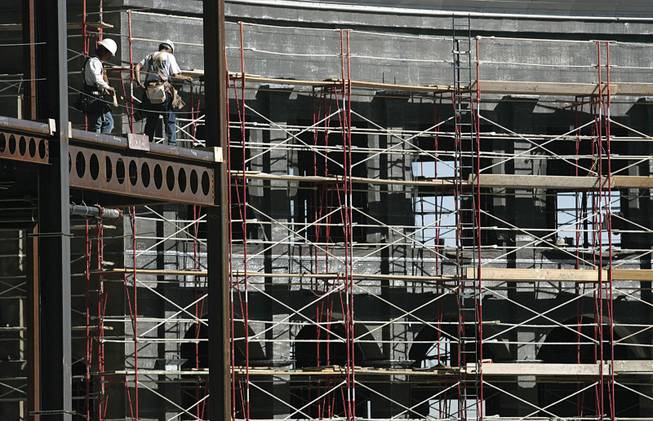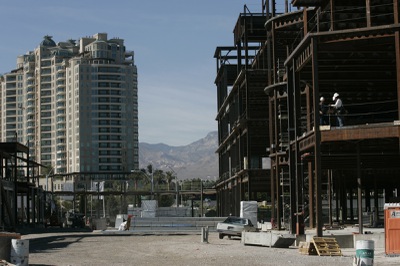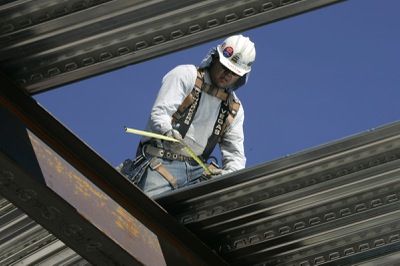
Construction continues this week at Tivoli Village at Queensridge at Rampart Boulevard and Alta Drive. Work resumed recently on the mixed-use development after construction was nearly halted a year ago. Commercial construction has slowed dramatically in Las Vegas.
Saturday, Nov. 7, 2009 | 2 a.m.
Sun Archives
- Commercial building headed for standstill (11-6-2009)
- Experts say economy crushing Las Vegas real estate market (10-30-2009)
- Q&A: Frank Gatski (10-20-2009)
- Commercial developers hope there’s nowhere to go but up (10-9-2009)
Sun Topics
Sun Coverage
The state bird of Nevada, the construction crane, is on the endangered species list.
The good news, at least, is that it still has a few places to roost — maybe an amazing achievement in itself, given the economic climate.
Las Vegas research firm Applied Analysis reports there are nine commercial projects of consequence under construction off from the Strip in Southern Nevada. Once most of those projects wind down early next year, there’s not much in the pipeline and development will essentially cease, said Jake Joyce, an analyst with Applied Analysis.
“With limited projects remaining under construction, the build-it-and-they-will-come mentality has gone the way of pillbox hats, Benny Goodman and your grandmother’s dance card,” Joyce said. “Essentially, commercial is following the same path as tourism. It is about supply and demand.”
After the completion of CityCenter, the most prominent project under construction will be Tivoli Village at Queensridge, which recently resumed work on its mixed-use development after virtually halting it a year ago. Also, Marnell Properties on Monday will break ground on a 200,928-square-foot airfreight logistics center on McCarran International Airport’s new Terminal 3.
With the completion of most of CityCenter in December, the long-range outlook, analysts say, is that there won’t be another major casino project built on the Strip for another decade.
With commercial vacancy rates at record levels, weak demand because of the economy and job market, and with credit hard to obtain, the chance for new projects is low. Las Vegas now has the same amount of space occupied as it did in 2006, and there’s been millions of square feet added since then.
“It will be pretty bad,” said John Restrepo, principal of Restrepo Consulting. “We are going to have a drought of commercial construction for a number of years until we burn through this inventory.”
Commercial has nearly caught up with the home construction industry, in which builders are taking only about 400 permits a month because of weak demand given the foreclosure inventory. Fewer than 5,000 homes will be built in 2009, compared with more than 35,000 a year during the boom.
The office market has 11.2 million square feet of empty space with a vacancy rate of nearly 23 percent. That equates to about five years of inventory, Joyce said.
With the unemployment rate in Las Vegas at 13.9 percent and rising, there won’t be job creation to spur demand for office and industrial space, Joyce said.
The industrial real estate market is hurting too, with 13 million square feet of vacant industrial space, which is about two years of inventory.
The retail sector has 5.1 million square feet of vacant space, a supply of about two years, Joyce said.
With foreclosures expected to increase in 2010, the value of vacant commercial space will slide and make it more difficult for developers to build anything that can be competitive, analysts said.
Besides Tivoli Village, another project kicking off is a $29 million freight and mail sorting operation for FedEx, UPS and airlines scheduled to be completed in about a year.
Analysts said projects such as the Marnell Air Cargo Center will proceed because they’re built specifically for companies rather than speculative development. The project is nearly fully pre-leased.
Other projects Applied Analysis reports are under construction off the Strip are:
• A 412,000-square-foot warehouse facility at the southwest corner of Sunset Road and Torrey Pines Drive.
• A 50,000-square-foot distribution center on Trade Drive in North Las Vegas.
• The 48,047-square-foot Tuscano Medical Park Building C on Jeffreys Street.
• The 130,000-square-foot Corporate Center at the Curve on West Teco Avenue.
• The Campos Office Building — 84,184 square feet of government office on Bonanza Road.
• Caroline’s Court — 258,210 square feet of retail at U.S. 95 and Durango Drive.
• Phase 2 of retail development totaling 101,550 square feet at Horizon Ridge and Green Valley parkways.
The list is telling because in early 2007 — when commercial construction was booming — there were 75 to 100 projects under construction, Joyce said.
At least three dozen office projects that Applied Analysis had previously listed as planned are on hold because they are no longer being marketed, Joyce said. That doesn’t include other projects under construction that have stalled because construction loans expired and banks won’t extend them.
“The banks are trying to shore up their balances and it doesn’t make sense to loan more money on a project that is going to sit vacant and they are eventually going to take back,” Joyce said.
Added Restrepo: “We won’t see much if any new spec commercial development until we see vacancies below 10 percent for an extended period of time.”
That’s quite a comedown for a region that had twice the construction employment as the national average. No one ever expected a slowdown of this magnitude, Restrepo said.
“Southern Nevada went through a long stretch having a disproportionate share of its job base in construction, at least by national standards. Many in the community started to believe that this reflected a normal and sustainable job base. The recession has dramatically shown how transitory construction employment really is,” Restrepo said.
In its latest quarterly report, the Associated General Contractors of Las Vegas said 19 commercial building permits were issued in September with a value of $10 million. Between September 2007 and September 2008 the value of commercial permits averaged $130 million per month.
Steve Holloway, the industry group’s executive director, said it may be another two to five years before commercial construction picks up in the private sector and that hope for the near term is expanded government spending.
The slowdown in construction has also prompted an exodus of construction workers because about 15,000 of the 50,000 union-hall workers are considered “travelers,” in that they relocate to markets temporarily for work and return home when work is no longer available, Holloway said.
“Once CityCenter is done, that is going to be it for a while,” Holloway said. “It is going to be ugly. There is so much supply that it will remain idle for a while. Unless some huge project magically takes off, I think Southern Nevada is going to remain in this recession two to five more years.”
Holloway said tourism won’t be enough to push Las Vegas out of its recession because construction is the second-largest industry in an economy predicated on growth. That industry pays more than 30 percent of sales and use taxes, he said.
“Unless construction recovers both nationally and locally, we are not coming out of this recession no matter what gaming does,” Holloway said.
A version of this story appears in In Business Las Vegas, a sister publication.



Join the Discussion:
Check this out for a full explanation of our conversion to the LiveFyre commenting system and instructions on how to sign up for an account.
Full comments policy